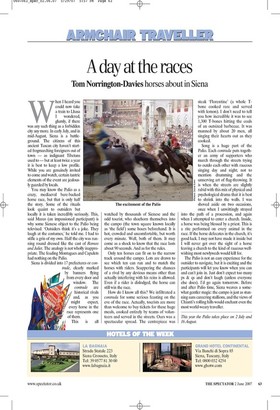A day at the races Tom Norrington-Davies horses ab
A day at the races Tom Norrington-Davies horses about in Siena Iv hen I heard you could now take a train to Lhasa I wondered, glumly, if there was any such thing as a forbidden city any more. In early July, and in mid-August, Siena is a battleground. The citizens of this ancient Tuscan city haven't started frogmarching foreigners out of town — as indignant Tibetans used to — but at least twice a year it is best to keep a low profile. While you are genuinely invited to come and watch, certain tantric elements of the event are jealously guarded by locals.
You may know the Palio as a crazy, mediaeval bare-backed horse race, but that is only half the story. Some of the rituals look quaint to outsiders but locally it is taken incredibly seriously. This, said Marco (an impassioned participant) is why some Sienese object to the Palio being televised. 'Outsiders think it's a joke. They laugh at the costumes,' he told me. I had to stifle a grin of my own. Half the city was running round dressed like the cast of Romeo and Juliet. The analogy is not wholly inappropriate. The feuding Montagues and Capulets had nothing on the Palio.
Siena is divided into 17 prefectures or contrade, clearly marked by banners flying from every door and window. The contrade are historical rivals and, as you might expect, every horse in the race represents one of them.
This is all I -11 watched by thousands of Sienese and the odd tourist, who shoehorn themselves into the campo (the town square known locally as `the field') some hours beforehand. It is hot, crowded and uncomfortable, but worth every minute. Well, both of them. It may come as a shock to know that the race lasts about 90 seconds. And as for the rules.
Only ten horses can fit on to the narrow track around the campo. Lots are drawn to see which ten can run and to match the horses with riders. Scuppering the chances of a rival by any devious means other than actually interfering with his reins is allowed. Even if a rider is dislodged, the horse can still win the race.
How do I know all this? We infiltrated a contrada for some serious feasting on the eve of the race. Actually, tourists are more than welcome to buy tickets for these huge meals, cooked entirely by teams of volunteers and served in the streets. Ours was a spectacular spread. The centrepiece was Picture: Jason Lowe steak 'Florentine' (a whole Tbone cooked rare and served with lemon). I don't need to tell you how incredible it was to see 1,300 T-bones hitting the coals of an outsized barbecue. It was manned by about 20 men, all singing their hearts out as they cooked.
Song is a huge part of the Palio. Each contrada puts together an army of supporters who march through the streets trying to outdo each other with raucous singing day and night; not to mention drumming and the unnerving art of flag-throwing. It is when the streets are slightly rabid with this mix of physical and psychological drama that it is best to shrink into the walls. I was shoved aside on two occasions, once when I unwittingly strayed into the path of a procession, and again when I attempted to enter a church. Inside, a horse was being blessed by a priest. This is a rite performed on every animal in the race. If the horse defecates in the church, it's good luck. I may not have made it inside but I will never get over the sight of a horse leaving a church to the kind of raucous wellwishing most newlyweds would kill for.
The Palio is not an easy experience for the outsider to navigate, but it is exciting and the participants will let you know when you can and can't join in. Just don't expect too many ps & qs and don't laugh (unless everyone else does). I'd go again tomorrow. Before and after Palio time, Siena weaves a somewhat gentler magic: the campo is just as stunning sans careering stallions, and the views of Chianti's rolling hills would enchant even the most world-weary traveller.
This year the Palio takes place on 2 July and 16 August.




















































 Previous page
Previous page